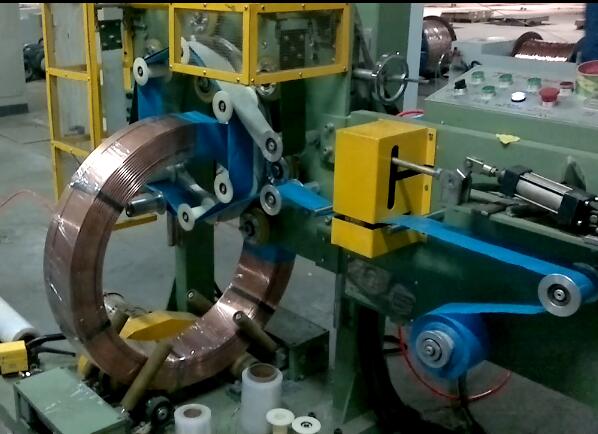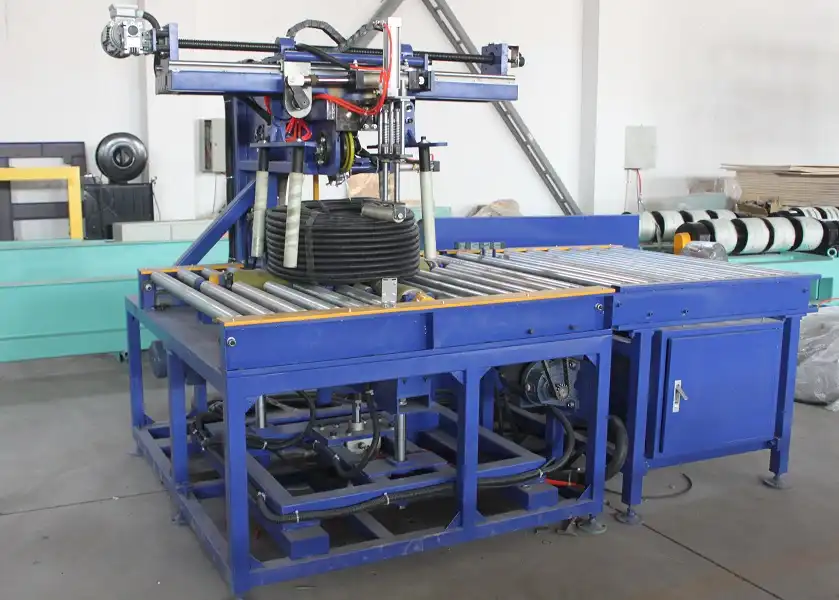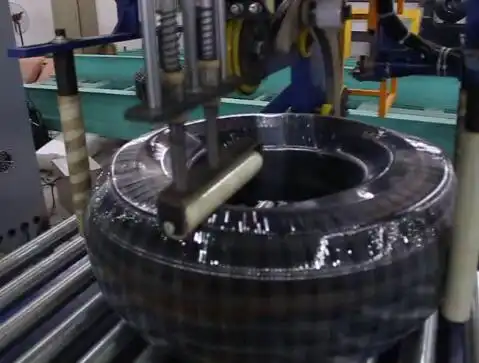Managing a distribution center that handles many different types of steel wire is a constant challenge. You're always under pressure to switch between different product specifications, from wire diameter to spool size. I know this process well. These manual changeovers are slow. They create serious bottlenecks that slow down your entire operation. This inefficiency leads to delays, missed deadlines, and can even damage your reputation with customers. But you can fix this. There is a clear, systematic way to boost your rewinding efficiency and get your products out the door faster.
Improving steel wire rewinding efficiency in a multi-product center means using a versatile rewinding machine, creating simple changeover procedures, and integrating automated packing systems. This approach reduces downtime between different product runs. It also cuts down on manual work. The result is a direct and significant increase in your facility's total output.

I've spent over two decades in the packing machine industry, first as an engineer and now as a factory owner myself. I've walked the floors of countless factories just like yours. I've seen the same struggles time and again. Managers like you are looking for more than just a piece of equipment. You need real solutions that solve fundamental problems in your workflow. In this article, I want to share my direct experience. We will break down the practical steps you can take. We will explore how to choose the right equipment and how to think about the investment, so you can transform your rewinding process from a bottleneck into a strength.
How can automating the rewinding process address safety and labor shortages?
You see your team handling heavy wire coils and spools every single day. As a manager, you carry the weight of their safety on your shoulders. The risk of a back injury or a crushed foot is always present. This constant worry is stressful, and the high insurance costs that come with it hurt your bottom line. At the same time, finding good people willing to do this physically demanding work is getting harder and harder. High employee turnover means you are always training new people. But automation offers a direct and powerful solution to both of these critical problems.
Automating the steel wire rewinding process improves safety by removing the need for workers to manually lift and handle heavy coils. It reduces the risk of injury to almost zero. This automation also solves labor shortages because it allows a single operator to safely oversee a process that used to require several people.

Let’s dive deeper into how this transformation actually happens on the factory floor. When I started my own factory, one of my first priorities was to engineer out the most dangerous manual tasks. The rewinding and packing area was at the top of my list.
From High Risk to High Tech
A fully manual rewinding process is filled with risks. Workers have to lift a heavy mother coil onto the payoff stand. Then they manually thread the wire. They control the tension by feel, which is inconsistent. Finally, they have to lift the heavy, finished spool off the machine. Each step is a potential point of failure or injury. Automation changes this entire picture. Modern automated rewinding lines incorporate features that directly address these risks. For example, hydraulic or pneumatic lifts can load and unload coils automatically. An operator simply pushes a button. The machine does the heavy work. This single feature eliminates the most common source of back injuries in this area.
Solving the Labor Puzzle
The issue of labor shortages is just as important. In many industrial areas, the workforce is aging, and fewer young people are entering physically demanding manufacturing jobs. Relying on a large team for your rewinding and packing is not a sustainable long-term strategy. Automation lets you do more with fewer people. An automated system can handle the entire rewinding cycle. It manages the speed, controls the tension for a perfect wind, and stops automatically when the target length is reached. An integrated system can even move the finished coil to the next station, like wrapping or strapping, without any human intervention. One skilled operator can then supervise multiple machines. Their job shifts from manual labor to process oversight. This makes the job more appealing, safer, and reduces your dependency on a large workforce.
Here is a simple comparison:
| Feature | Manual Rewinding Process | Automated Rewinding Process |
|---|---|---|
| Labor Required | 2-3 workers per station | 1 operator for multiple stations |
| Primary Injury Risk | High (back strain, crush injuries) | Very Low (operator is supervisory) |
| Consistency | Low (depends on operator skill) | High (machine-controlled parameters) |
| Changeover Time | High (manual adjustments) | Low (pre-programmed recipes) |
| Employee Turnover | High (due to physical demand) | Low (safer, more skilled position) |
By investing in automation, you are not just buying a machine. you are redesigning the job itself. You make it safer, more efficient, and more attractive to a modern workforce. This is a strategic move that pays dividends in safety, productivity, and employee retention for years to come.
What are the key features to look for in a rewinding machine for a multi-product environment?
Your distribution center is not handling just one type of wire. One day it’s a thick gauge steel wire, the next it’s a much thinner variety. You have different customers with different spool size requirements. This high-mix environment can cripple a standard rewinding machine. You spend more time setting up the machine for the next job than you do actually running it. This constant downtime kills your efficiency. You need a machine that is a workhorse, but also flexible enough to adapt quickly.
For a multi-product environment, look for a rewinding machine with quick-change tooling, programmable recipe controls, and adjustable tension systems. These features allow you to switch between different wire diameters and spool sizes with minimal downtime, making the machine truly efficient for high-mix operations.

Choosing the right machine is critical. I've learned that a low price tag often hides high operational costs. When you are evaluating a new rewinding machine for your varied product line, you need to look past the basic specifications. You must focus on the features that directly impact your changeover speed and operational flexibility.
The Power of Programmable Recipes
Imagine this scenario. You finish a run of 5mm wire on 50kg spools. The next order is for 2mm wire on 25kg spools. In a basic setup, your operator has to manually adjust the guides. They have to change the tension settings. They need to reprogram the length counter. This process can take 30 minutes or more, and it's easy to make a mistake. Now, imagine a machine with a programmable recipe system. Your operator simply selects the "2mm/25kg" recipe from a touchscreen menu. The machine automatically adjusts the guides, sets the correct tension profile, and loads all the right parameters. The changeover takes less than five minutes. This is not a luxury feature; it's essential for any multi-product center. When you can save 25 minutes on every changeover, and you have multiple changeovers per day, the time savings add up incredibly fast.
Versatility in Hardware and Software
The machine's physical design is just as important as its software. You need a machine built for flexibility.
- Adjustable Payoff and Take-up: The machine must be able to handle a wide range of mother coil and destination spool sizes and weights. Look for easily adjustable chucks or shafts that don't require complex tools for a changeover.
- Precision Tension Control: Different wire types and diameters require different winding tension. A machine with a dynamic, closed-loop tension control system is crucial. It uses sensors to constantly monitor and adjust tension. This ensures a perfect, tight wrap every time, regardless of the wire type. This prevents issues like loose coils or wire damage.
- Robust Construction: Your machine will be running hard, day in and day out. Don't overlook the build quality. Look for a heavy-duty steel frame, high-quality motors and drives from reputable brands, and easy access to maintenance points. A durable machine will save you a fortune in repairs and downtime.
Here is a table of essential features to look for:
| Feature | Why It's Important for a Multi-Product Center | What to Look For |
|---|---|---|
| Recipe Management System | Drastically reduces changeover time and errors. | Touchscreen HMI, ability to store 50+ recipes. |
| Quick-Change Tooling | Allows for fast physical swaps of spools/coils. | Tool-less chucks, quick-release guides. |
| Automatic Tension Control | Ensures consistent quality across different wire types. | Servo-driven, closed-loop feedback system. |
| Heavy-Duty Frame | Guarantees reliability and long operational life. | Welded steel construction, oversized components. |
| Integrated Safety | Protects operators during operation and changeovers. | Light curtains, safety interlocks, emergency stops. |
When you focus on these key features, you choose a machine that is an asset, not a liability. It will adapt to your business needs, not force your business to adapt to its limitations. This is the secret to true efficiency in a high-mix environment.
How do you calculate the real ROI of a new rewinding and packing line?
As a factory manager, every major purchase comes down to one question: will this investment pay for itself? It’s easy to get lost in the technical specifications and sales pitches. But you are responsible for the financial health of your operation. You need to justify the expense with a clear return on investment (ROI). Just looking at the purchase price is a common mistake. The true ROI comes from a much deeper analysis of cost savings and efficiency gains over the entire life of the equipment.
To calculate the real ROI of a new rewinding and packing line, you must look beyond the initial cost. You need to add up the total savings from reduced labor, eliminated product damage, and increased throughput. Then, you divide the initial investment by these annual savings to find the payback period.
I've helped many clients, just like you, work through this calculation. It’s a process that brings clarity and confidence to the decision. It transforms the purchase from an expense into a strategic investment in your factory's future. Let’s break down the components of a real ROI calculation.
Calculating Your Annual Savings
The first step is to quantify all the ways the new automated line will save you money. Be conservative with your estimates, but be thorough.
- Labor Cost Reduction: This is the most obvious saving. Let’s say your current manual process requires two workers per shift, and you run two shifts. Each worker costs you $40,000 per year in salary and benefits. Your total annual labor cost is 4 x $40,000 = $160,000. The new automated line only needs one operator to supervise. That operator might be more skilled, so their cost is $50,000 per year. Your new labor cost is $50,000. The annual saving is $110,000.
- Reduced Product Damage: Your current manual process results in damaged steel coils, especially on the edges. Let's say you scrap or discount 1% of your product due to this damage. If you produce $5 million worth of wire annually, that's a $50,000 loss. An automated line with proper tension control and handling can reduce this loss to almost zero. Let's conservatively say it reduces it by 90%. That's an annual saving of $45,000.
- Increased Throughput (Profit Gain): This is a gain, not a cost saving, but it's a critical part of ROI. Your current bottleneck limits your output. Let's say the new line allows you to produce and ship 20% more product with the same number of shifts. If your profit margin is 10% on that additional volume of $1 million (20% of $5M), that's an extra $100,000 in profit per year.
Putting It All Together
Now, let's create a simple ROI table.
| ROI Calculation Component | Annual Value |
|---|---|
| A. Annual Labor Savings | $110,000 |
| B. Annual Product Damage Savings | $45,000 |
| C. Annual Profit from Increased Throughput | $100,000 |
| D. Total Annual Return (A + B + C) | $255,000 |
| E. Total Investment (Machine + Install) | $350,000 |
| Payback Period (E / D) | 1.37 Years |
In this realistic example, the new automated line pays for itself in less than 1.5 years. After that, it generates an additional $255,000 in value for your business every single year. When you present the investment this way, with clear, conservative numbers based on your own operation, the decision becomes simple. It's not about spending money. It's about investing money to make much more money in return. This is the language of business, and it’s how you get major projects approved.
My Insight: Why is finding the right partner more important than finding the cheapest machine?
You have probably dealt with equipment suppliers before. Some of them are great. But many are only focused on one thing: making the sale. They promise you the world to get your signature on a purchase order. Then, when the machine arrives and you have a problem, they are nowhere to be found. This experience creates a crisis of trust. You become very cautious, and for good reason. I have seen this happen too many times. This is why I believe the most important decision you will make is not which machine to buy, but which partner to work with.
Finding the right partner is more important than finding the cheapest machine because a true partner understands your challenges, provides expert guidance beyond the sale, and offers reliable support to ensure your long-term success. A cheap machine with poor support is a liability, but the right machine from a great partner is a powerful asset.

When I built my own packing machine factory, I didn't just become a seller of machines. I became a user of them. I faced the same challenges my clients face: production pressures, maintenance headaches, and the need for reliable equipment. This journey from engineer to factory owner taught me the most valuable lesson in this industry. A machine is only a tool. Its real value comes from the expertise and support that stand behind it.
A Partner Solves Problems, A Seller Sells Products
Think about the challenges you face right now. Efficiency bottlenecks, safety hazards, product damage. A typical salesperson might show you a machine that can wrap a coil. A true partner, especially one with a background like mine, will first ask why you have these bottlenecks. They will want to understand your entire process, from when the raw material arrives to when the finished product ships. They will use their experience to see things you might miss. Maybe the problem isn't just the rewinding speed, but the way coils are moved to the packing station. A good partner will help you design a total solution, not just sell you a machine. This is the core philosophy of my company, SHJLPACK.
Look for Shared Experience and Long-Term Support
When you are talking to a potential supplier, don't just ask about the machine's price. Ask about their background. Ask them to share a story about a client they helped who had a problem similar to yours.
Here are the signs of a true partner versus a simple vendor:
| A Partner... | A Vendor... |
|---|---|
| Asks about your business goals and challenges. | Asks about your budget. |
| Offers a solution that integrates into your line. | Offers a standalone machine. |
| Discusses ROI, safety, and efficiency. | Discusses features and specifications. |
| Provides detailed post-sale support plans. | Disappears after the installation. |
| Has deep industry experience (like engineering/manufacturing). | Has a background only in sales. |
Your goal is to find a partner who is invested in your success. You want someone you can call in two years when you want to expand your line or troubleshoot a new issue. The initial price of the machine is a one-time cost. The cost of poor support, downtime, and unresolved problems is a cost that you will pay forever. Choosing the right partner is the best investment you can make in your factory's future. It provides peace of mind, which is something you can't put a price on.
Conclusion
Improving rewinding efficiency is achievable. By focusing on automation, smart machine selection, clear ROI, and finding a true partner, you can transform your operations and drive significant growth.




